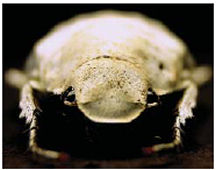Microstructures make a beetle brilliant
Engineers looking to make a variety of surfaces whiter and brighter could learn a few things from a lowly beetle, a new study suggests.

The tiny scales that cover several beetles in the Cyphochilus genus of southeastern Asia are much whiter than natural substances such as milk and tooth enamel and are almost as bright as a sheet of paper, says Pete Vukusic, a physicist at Exeter University in England.
Microscopic analyses of white Cyphochilus scales show that their brilliance isn’t a result of any pigment. Indeed, the scales are made of a translucent material called chitin. The whiteness of the 5-micrometer-thick scales stems from their internal microstructure—a loosely packed, chaotic network of chitin filaments. The random orientation and spacing of the 250-nanometer-diameter fibers causes the scales to reflect all visible wavelengths equally, making them appear white.
Manufactured materials that duplicate the microstructures in Cyphochilus scales could have a variety of uses, Vukusic and his colleagues suggest in the Jan. 19 Science. Such substances might replace some or all of the tons of minerals used each year to brighten the surface of paper, or they could be incorporated into tooth-whitening veneers. Also, engineers could use the material to line the inside of light fixtures, making them more energy-efficient.







